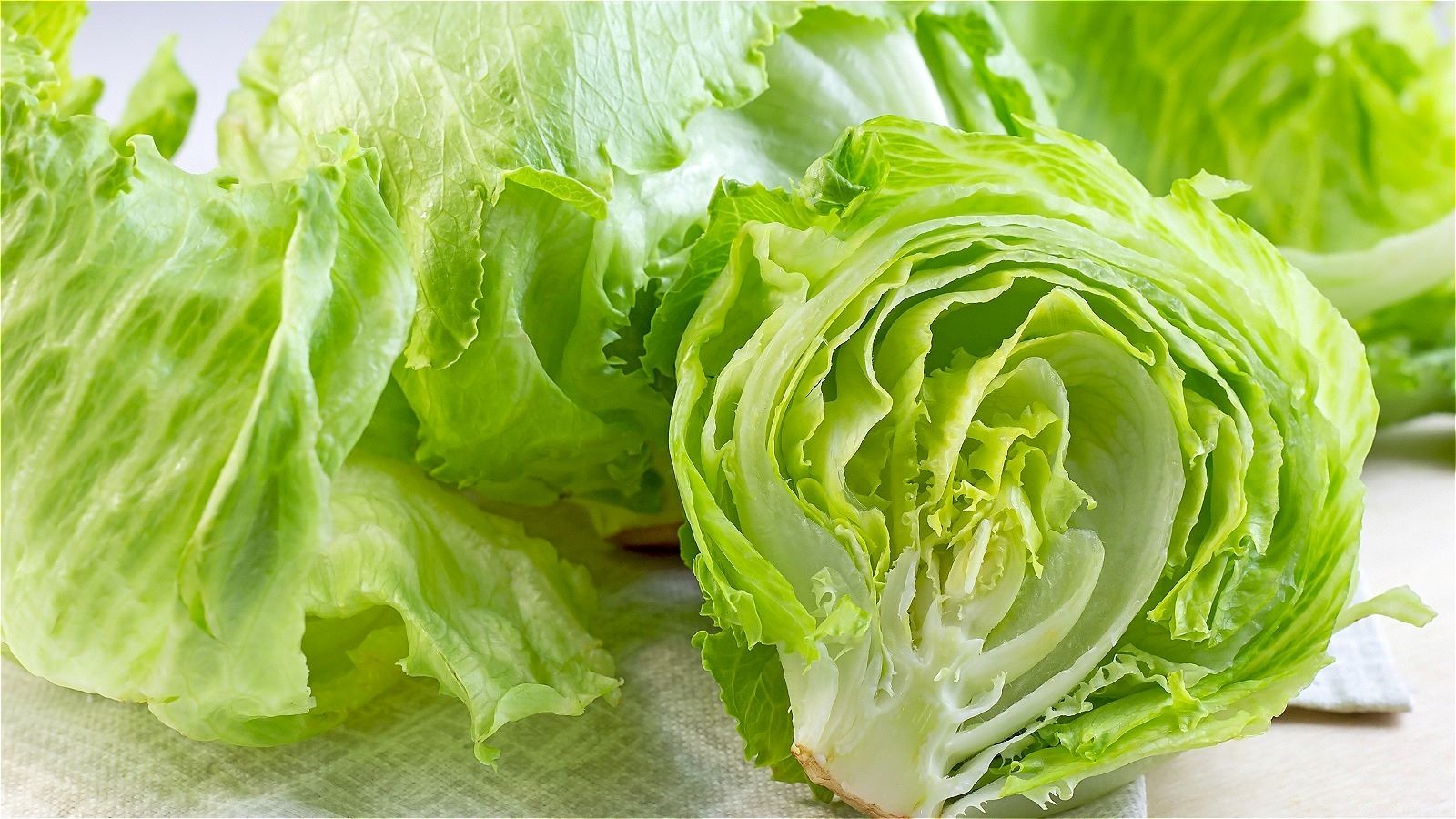

Articles
How To Store Iceberg Lettuce In Fridge
Modified: March 2, 2024
Learn the best methods for storing iceberg lettuce in the fridge to keep it fresh and crispy. Read our informative articles now
(Many of the links in this article redirect to a specific reviewed product. Your purchase of these products through affiliate links helps to generate commission for Storables.com, at no extra cost. Learn more)
Introduction
Welcome to our comprehensive guide on how to store iceberg lettuce in the fridge. Iceberg lettuce is a popular leafy green vegetable that is widely used in salads, sandwiches, and wraps. It is known for its crispy texture and refreshing taste. However, if not stored properly, iceberg lettuce can quickly become wilted and lose its flavor.
In this article, we will explore the importance of storing iceberg lettuce correctly to maximize its freshness and longevity. We will delve into the factors that contribute to the deterioration of lettuce and provide you with a step-by-step guide on how to store it in the fridge to maintain its crispness and nutritional value. Additionally, we will share some valuable tips and alternative storage methods to help you make the most out of your iceberg lettuce.
Whether you grow your own lettuce or purchase it from the market, proper storage is essential to preserve its quality and extend its shelf life. By following our expert tips, you can ensure that your iceberg lettuce remains fresh and vibrant for longer, allowing you to enjoy its delicious flavors and reap its nutritional benefits.
Key Takeaways:
- Proper storage of iceberg lettuce is crucial to retain its nutritional value, prolong shelf life, prevent wastage, maintain freshness, and optimize flavor. Follow expert tips for crisp, vibrant lettuce.
- Consider alternative storage methods like rooting in water, vacuum-sealing, or freezing to preserve iceberg lettuce based on your specific needs and usage. Refrigeration remains the most common and convenient method.
Read more: How To Store Iceberg Lettuce
Why is it important to store iceberg lettuce correctly?
Storing iceberg lettuce correctly is crucial for maintaining its freshness, crispness, and flavor. Here are a few reasons why proper storage is important:
Retaining Nutritional Value
Iceberg lettuce is a nutritious vegetable that contains essential vitamins, minerals, and fiber. However, improper storage can cause a loss of nutrients. By storing iceberg lettuce correctly, you can help preserve its nutritional value, ensuring that you get the maximum health benefits from consuming it.
Prolonging Shelf Life
When iceberg lettuce is not stored properly, it tends to deteriorate quickly. This can lead to wilting, browning, and overall degradation in quality. By storing it correctly, you can extend its shelf life, allowing you to enjoy fresh and crisp lettuce for a longer period.
Preventing Wastage
Improper storage often leads to wastage, as lettuce becomes limp, slimy, or unusable. By knowing how to store iceberg lettuce correctly, you can minimize wastage and save money by utilizing the full potential of this versatile vegetable.
Read more: How To Store Cut Iceberg Lettuce
Maintaining Freshness
Iceberg lettuce is prized for its crunchy texture and refreshing taste. Storing it correctly helps maintain its freshness, allowing you to savor the crisp bites and enjoy the vibrant flavors in your salads or sandwiches.
Optimizing Flavor
Proper storage helps preserve the natural flavor of iceberg lettuce. By keeping it at the optimal temperature and humidity level, you can prevent the leaves from becoming bitter or losing their delicate taste.
In summary, storing iceberg lettuce correctly is essential to retain its nutritional value, prolong its shelf life, prevent wastage, maintain freshness, and optimize flavor. By following the right storage techniques, you can ensure that your iceberg lettuce stays crisp, vibrant, and delicious for a longer period.
Factors to consider before storing iceberg lettuce
Before storing iceberg lettuce in the fridge, it is important to take into account several factors that can affect its freshness and quality. By considering these factors, you can ensure that your lettuce stays in optimal condition. Here are some key factors to keep in mind:
Quality of lettuce:
Choose iceberg lettuce that is fresh, crisp, and free from any signs of wilting, browning, or discoloration. Avoid lettuce with bruised or damaged leaves, as these are more prone to spoilage.
Read more: How To Store Iceberg Lettuce After Cutting
Washing the lettuce:
It is crucial to wash iceberg lettuce thoroughly before storing it. Washing helps remove any dirt, bacteria, or pesticide residue that may be present on the leaves. Be sure to dry the lettuce thoroughly after washing, as excess moisture can lead to faster decay.
Trimming the lettuce:
Before storing, trim off the outer leaves of the lettuce, as they are more likely to wilt and spoil quickly. Retain only the fresh, crisp inner leaves for storage.
Storage container:
Choose a suitable storage container for your iceberg lettuce. Opt for a clean, airtight container that is large enough to accommodate the lettuce without causing overcrowding or excessive compression. Make sure the container has good ventilation to prevent the buildup of moisture.
Temperature and humidity:
Iceberg lettuce is best stored at a temperature between 32°F (0°C) to 40°F (4°C). Keep the humidity level relatively high to prevent the lettuce from drying out. However, excessive moisture can also promote decay, so it’s important to strike a balance.
Read more: How To Store Iceberg Lettuce To Last Longer
Separate storage:
Store iceberg lettuce separately from other fruits and vegetables, as some produce emits ethylene gas, which can cause lettuce to spoil more quickly. Keeping them apart helps prolong the freshness of the lettuce.
By considering these factors and implementing the appropriate measures, you can ensure that your iceberg lettuce remains fresh, crisp, and flavorful for an extended period of time.
Step-by-step guide on storing iceberg lettuce in the fridge
Properly storing iceberg lettuce in the fridge helps maintain its freshness and crispness for an extended period. Follow this step-by-step guide to ensure that your lettuce stays in optimal condition:
Step 1: Select fresh iceberg lettuce:
Choose iceberg lettuce that is fresh, with crisp leaves and vibrant color. Avoid lettuce that shows signs of wilting, browning, or damage.
Step 2: Wash the lettuce:
Thoroughly wash the iceberg lettuce to remove any dirt, debris, or pesticide residue. Gently rinse the leaves under cool running water, making sure to reach all areas. Pat dry the lettuce using paper towels or a clean kitchen towel to remove excess moisture.
Read more: How To Store Iceberg Lettuce After Washing
Step 3: Trim the lettuce:
Trim off the outer leaves of the lettuce, as they are more likely to wilt and spoil faster. Retain only the fresh inner leaves for storage.
Step 4: Store in an airtight container:
Place the trimmed iceberg lettuce in a clean, airtight container. Ensure that the container is large enough to accommodate the lettuce without causing overcrowding. Don’t compress it too tightly, as this can lead to bruising. Leave some room for air circulation.
Step 5: Add a paper towel:
Line the bottom of the container with a paper towel. This will help absorb excess moisture and maintain the desired level of humidity. You can also place another paper towel on top of the lettuce to further absorb moisture.
Step 6: Set the fridge temperature:
Adjust the temperature of your fridge to around 32°F (0°C) to 40°F (4°C). This temperature range is ideal for keeping iceberg lettuce fresh and crisp. Remember, the lower the temperature, the longer the lettuce will stay fresh.
Read more: How To Store Butter Lettuce In The Fridge
Step 7: Store on a shelf:
Place the container of iceberg lettuce on a shelf in the refrigerator, away from direct exposure to the coldest areas like the back of the fridge or near the vents. This will protect the lettuce from extreme temperatures.
Step 8: Check and rinse if needed:
Regularly check the iceberg lettuce for any signs of wilting or decay. If you notice any damaged or spoiled leaves, remove them promptly. If necessary, rinse the lettuce again before using, but be sure to dry it thoroughly.
By following these simple steps, you can properly store iceberg lettuce in the fridge and enjoy fresh, crispy lettuce whenever you need it.
Tips for maintaining the freshness of iceberg lettuce
To ensure the longevity and freshness of iceberg lettuce, it’s important to implement a few simple yet effective practices. Here are some valuable tips to help you maintain the crispness and flavor of your lettuce:
1. Don’t wash until ready to use:
Washing iceberg lettuce too far in advance can cause excess moisture, leading to faster wilting and decay. It’s best to wait and wash the lettuce right before you plan to use it.
Read more: How To Store Lettuce
2. Store unwashed lettuce:
Before storing in the fridge, avoid washing iceberg lettuce. Moisture is the enemy of freshness, so storing unwashed lettuce minimizes the risk of excess moisture content.
3. Use a lettuce spinner:
If you prefer to wash the lettuce before storing, invest in a lettuce spinner. This handy tool helps remove excess water from the leaves, ensuring they are as dry as possible before storage.
4. Replace damp paper towels:
If you notice that the paper towels inside the storage container have become damp or wet, replace them with dry ones. Excess moisture can promote decay, so it’s important to maintain a dry environment.
5. Store in a crisper drawer:
If your fridge has a designated crisper drawer, store iceberg lettuce in it. Crisper drawers often have adjustable humidity settings, allowing you to create an environment that is ideal for preserving freshness.
Read more: How To Store Living Lettuce
6. Avoid overcrowding:
Avoid overcrowding the lettuce in the storage container. Overcrowding can lead to compression and bruising, which accelerates spoilage. Leave enough space for air circulation around each leaf.
7. Don’t chop in advance:
If you don’t plan on using all the lettuce at once, avoid chopping or tearing it until you’re ready to eat or prepare your dish. Whole heads of lettuce tend to stay fresher longer than pre-cut or torn leaves.
8. Minimize exposure to ethylene:
Some fruits, such as apples and bananas, release a natural gas called ethylene, which can accelerate the ripening and spoilage of iceberg lettuce. Store lettuce away from ethylene-producing fruits to maintain its freshness.
9. Revive wilted lettuce:
If you find that your iceberg lettuce has become slightly wilted, you can try reviving it by soaking it in a bowl of ice water for a few minutes. This can help restore some of its crispness and make it vibrant again.
By following these tips, you can prolong the freshness and quality of your iceberg lettuce, ensuring that it remains crisp, vibrant, and delicious for your salads, sandwiches, or any other culinary creations.
Read more: How To Store Lettuce In Refrigerator
Alternative storage methods for iceberg lettuce
While storing iceberg lettuce in the refrigerator is the most common method, there are alternative ways to preserve the freshness of this leafy green. Here are a few alternative storage methods that you can consider:
1. Rooting in water:
If you have a fresh, whole head of iceberg lettuce, you can try rooting it in water. Cut off the bottom inch of the stem and place it in a glass or jar filled with about an inch of water. Keep the glass or jar in a well-lit area, changing the water every few days. The lettuce will continue to grow and can be harvested as needed.
2. Vacuum-sealed bags:
Using a vacuum sealer, you can remove the air from the bags and seal in the freshness of iceberg lettuce. This method helps to prevent wilting and extends the shelf life of the lettuce. However, be aware that vacuum sealing the lettuce may cause slight bruising or compression.
3. Storing in a perforated bag:
Place your iceberg lettuce in a perforated bag or a plastic bag with small punctures. This allows for some air circulation while retaining moisture. Remember to tie or seal the bag loosely to prevent strangling the lettuce.
Read more: How To Store Romain Lettuce
4. Freezing:
If you have an abundance of iceberg lettuce and want to preserve it for an extended period, you can freeze it. Blanch the lettuce by immersing it in boiling water for a minute or two, then transfer it to an ice bath to cool. Pat dry the leaves and place them in freezer-safe bags or containers. Frozen lettuce may lose some of its crispness, but it can still be used in cooked dishes like soups, stews, or stir-fries.
5. Wrapping in paper towels:
If you find that your iceberg lettuce tends to wilt quickly in the refrigerator, you can try wrapping it in paper towels to absorb excess moisture. After washing and drying the lettuce, wrap it loosely in paper towels before storing it in a plastic bag or airtight container.
6. Hydroponic storage:
If you have the resources and space, you can explore hydroponic storage methods. This involves growing iceberg lettuce in a water-based nutrient solution, without the need for soil. Hydroponics provides optimal conditions for lettuce growth and can help extend its freshness.
Remember that while these alternative storage methods can help preserve iceberg lettuce in different ways, the refrigeration method remains the most common and convenient for everyday use. Choose a storage method that suits your needs and preferences, ensuring that the lettuce stays fresh and ready for consumption whenever you desire.
Conclusion
Properly storing iceberg lettuce is essential to maintain its freshness, crispness, and flavor. By following the guidelines outlined in this comprehensive guide, you can extend the shelf life of your lettuce and make the most out of this versatile leafy green vegetable.
Remember to select high-quality lettuce, wash it before storing or right before use, and trim off any damaged leaves. Use an airtight container with proper ventilation to store the lettuce in the refrigerator at the right temperature and humidity level. Take care to avoid overcrowding, minimize exposure to ethylene-producing fruits, and keep the lettuce dry to prevent moisture-related decay.
In addition to these standard storage practices, consider alternative methods such as rooting in water, vacuum-sealing, or freezing lettuce to suit your specific needs. Each method offers its own benefits and can be used depending on the quantity of lettuce you have and your desired usage.
By implementing these tips and techniques, you can enjoy fresh, crisp iceberg lettuce for a longer period, reducing wastage and ensuring that you have delicious, nutritious lettuce for your salads, sandwiches, and other culinary creations.
So, the next time you bring home a head of iceberg lettuce, remember the importance of proper storage and take the necessary steps to keep it at its best. Your taste buds and your health will thank you for it!
Frequently Asked Questions about How To Store Iceberg Lettuce In Fridge
Was this page helpful?
At Storables.com, we guarantee accurate and reliable information. Our content, validated by Expert Board Contributors, is crafted following stringent Editorial Policies. We're committed to providing you with well-researched, expert-backed insights for all your informational needs.







0 thoughts on “How To Store Iceberg Lettuce In Fridge”